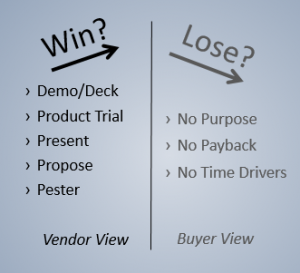Sales Forecasting failure – and finding victory

Sales Forecasting in B2B sales is an art form, according to some observers. Asking sales people for “Confidence level” or “Win % probability” leads to a long list of over-stated opportunities. Overstated usually means that results will be under 50% of forecast. Management suddenly realizes there are too many stalled Deals. The common thread of overstatement is that we are doing all of our usual sales activities with a “vendor view”, running as fast as we can like a hamster in his wheel. Surely if we run faster we’ll get there sooner. Right? Surely if we do more demos, quotes and proposals we can forecast more business? In this environment we often end up with a growth in the quantity of active Deals, with a serious decline in sales forecasting quality. Customers worsen matters by asking for a quote. We react by submitting proposals too early. We invest too little time considering the underpinning of a failure scenario – i.e. how could this offer be refused by the Buyer? For “the Buyer”, I mean the economic buyer who is the CEO or a VP with budget authority, and many alternate ways to allocate funding.
Sales Forecasting – What if we forecast “Failure % probability” instead?
In this world-view I am assuming that there are two fundamental questions in sales forecasting – How could we win? and How could we Lose? Let’s say we have a salesman declaring that he has an “80% confidence level” that he will win, and the opportunity will close. And suppose the manager has a set of test questions that leave her thinking “there is a 60% chance this opportunity will fail to close.” Does this add up? No, it does not. The two possible outcomes can only have a 100% total.
A total of 140% means that the Will-we-win conversation has taken a wild wrong turn into a personal discussion of professional confidence. The more work done on a Deal, the more confidence a sales person expects himself or herself to show. Hence there is usually a ratchet effect. Deals go from month to month at a % confidence level that goes up, never down. This continues until a total failure is declared.
Looking at a failure forecast is a matter of looking at something hidden in the shadows for us, but something the Buyer is very familiar with. Buyers get a lot of proposals – how many people come into their offices every day? How many vendors and staff are proposing a way to allocate company resources? My experience is that executive Buyers have certain typical questions for any proposal, which help us understand the Will-we-lose probabilities. These three questions need high quality answers, or the proposal will be refused. These are the test questions a sales manager can use in a forecasting meeting with a sales person, as part of a superior sales coaching approach:
- What is the buyer Purpose?
- What is the buyer Payback?
- What drives the buyer to do this now – the reason for urgency?
Remember, these questions are about the customer’s internal drivers, and a high quality answer has specific customer details. As a manager, you need to put yourself in a seat with the “Buyer View”. Your sales people and proposals must state specific ways the Buyer’s existing business and processes will be improved. If they can’t or don’t, assume there is a high likelihood the Deal will go stalled or lost. Then you should get the sales person’s effort re-directed to closing the discovered gap, which means working closely with the champion to create a high quality, written line of reasoning to define purpose, payback (or value) and time drivers for the purchase.
Meanwhile, in sales forecasting, delay the estimated sign date. When a sign date is delayed, it is also wise to reduce the % Progress on that Deal, to reflect the change in risk. This will help management avoid the ravages of false upward Sales Forecasting spirals.
In summary, finding victory for your own sales forecasting has several components. First, change the rules on who does Sales Forecasting – the sales people perform sales activities with Buyer impact, and the managers do sales forecasting. And:
- Do NOT ask sales people for their opinions on “% Probability” or “% Confidence Level”
- Ask sales people about Time drivers – what will Buyer achieve with your offer, once it is received and in use? How does that relate to existing corporate goals this fiscal year, and programs the Buyer has in motion?
- Ask sales people about Buyer purpose and Buyer payback
- Design your Deal funnel stages to be “Impact-centric” on Buyer purpose, payback and time drivers
- Design a Deal scoring system to weight a blend of both “Why we win” and “Why we lose”, and tune it as you gain experience
Avoid using sales forecasting to set targets or stretch targets – if you get tempted to do this, better to just set the targets in plain site, and hide the forecast completely. The forecast needs to be a document prepared and used only by management, with its much better sense of reality.



Follow Us
Follow us on LinkedIn for updates.